Abstract
Abstract—Injury is the leading cause of mortality in people younger than 44 years of age. Injury prevention laws and policies are not only effective in saving lives at a population level but are also remarkably cost-effective compared to most public health interventions. For example, the implementation of a stricter Massachusetts Graduated Driver Licensing Law in 2007 resulted in a very significant and rapid decrease in the rates of motor vehicle crashes of teenager drivers, saved thousands of lives, and resulted in more than $10 million dollars savings in health care costs over 5 years. We therefore suggest that trauma and injury prevention should be made a priority in any attempt at local, regional, or national health system reform.
INTRODUCTION
As health care policy makers strive to simultaneously improve care, reduce costs, and provide equitable access to care, primary and secondary disease prevention must be prioritized. Prevention strategies have traditionally focused on the prevention of rapidly endemic infectious diseases through the use of vaccines, prevention of chronic disease such as diabetes and heart disease through diet and lifestyle modifications (e.g., smoking cessation), and secondary prevention of cancer through the adoption of cost-effective screening techniques (e.g., screening endoscopy for colon cancer). Despite the large and costly burden of disease resulting from both intentional and unintentional injury, most of which falls on the youngest and most productive section of society, injury prevention has relatively lagged behind in most health system reform efforts. In this article, we (1) review the burden, secular trends, and variability in injury rates in the United States and (2) suggest that injury prevention is cost-effective and should be a priority in the agenda of any local, regional, or national health system reform. As a specific example, we will outline how one law, the Graduated Driver Licensing Law in the state of Massachusetts, simultaneously reduced injuries and injury-related fatalities as well as direct health care costs in a very vulnerable population.
THE TRAUMA AND INJURY BURDEN IN THE UNITED STATES
Injury accounts for at least 38% of the burden of surgical diseaseCitation1 and has been described in 1966 by the National Academy of Sciences as the neglected disease of modern society.Citation2 Approximately 5 million people worldwide die each year from injury.Citation3 According to the US Centers for Disease Control and Prevention, violence and injuries are currently the leading cause of death in Americans aged one to 44 () and cost more than 406 billion USD per year in medical care and lost productivity.Citation4,5 Two types of injuries are included in the analysis: unintentional injuries (e.g., falls, motor vehicle crashes [MVCs], accidental drowning) and intentional injuries (e.g., homicide, suicide, child maltreatment). Together, intentional and unintentional injuries accounted for 59% of deaths for those age one to 44 years old, 2.5 million hospitalizations, and 31 million emergency department visits in 2013.Citation6 Injuries can affect all people regardless of age, race, or socioeconomic status, although those at highest risk are typically males of lower income and education.Citation7
Figure 1. Leading Causes of Death in Patients One to 44 Years Old in the United States in 2013. Source: CDC37
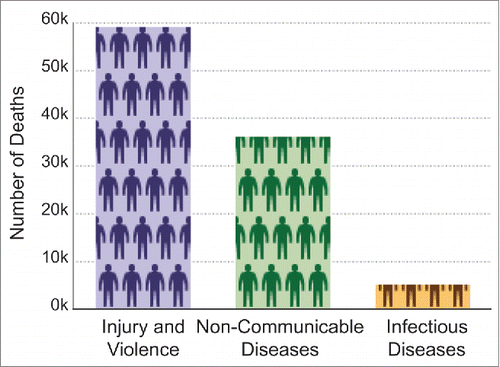
Alarmingly, though death rates in the United States from infectious diseases have dropped dramatically in the past 100 years, the death rate from trauma and injuries has not been decreasing at the same rate ().Citation8 In addition, considerable variability in the fatality rates from injury exists across the country, at least partly reflecting the heterogeneity in adoption, strictness, and implementation of injury prevention policies and laws at the state level ().
Figure 2. The 1900–2000 Trends in Mortality for People Aged One to 24 Years in the United States. Source: CDC38
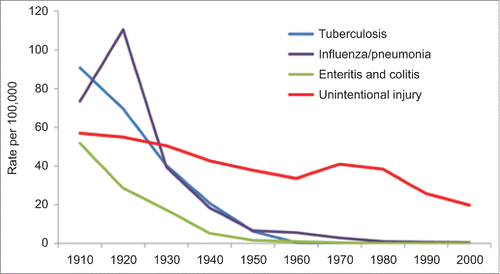
Figure 3. Unintentional Injury Death Rates per 100,000 People Aged Zero to 19 Years in the United States Between 2000 and 2006. Source: CDC38
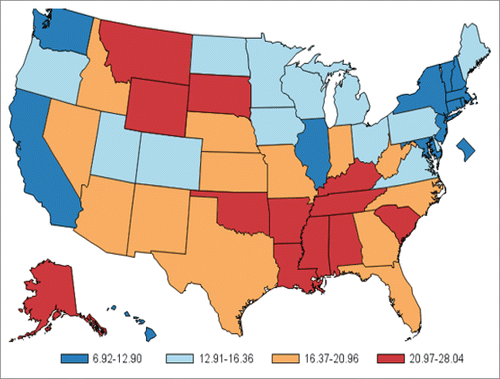
COST-EFFECTIVENESS OF INJURY PREVENTION INTERVENTIONS
Money spent on injury prevention has been shown to reduce costs. For every dollar spent on booster seats to prevent a secondary child injury in an MVC, 71 USD is saved in costs to society.Citation9 Similarly, for every dollar spent on bicycle helmets, 48 USD is saved in societal costs due to secondary prevention of traumatic brain injury in bicycle crashes, and every dollar spent on childproof cigarette lighters saves 72 USD in societal costs related to injury prevented. Such return on investment and value obtained from these injury prevention interventions are in line with the most cost-effective known public health interventions.
MOTOR VEHICLE CRASHES: A PANDEMIC
Among all causes of trauma, MVCs remain the leading cause of injury-related death in the United States,Citation10 and alcohol is a clear and major contributing factor. In 2012, more than 10,000 people were killed in alcohol-related MVCs in the United States; this high number constitutes almost a third (31%) of all traffic-related deaths.Citation1 The concomitant cost associated with alcohol-related MVCs (i.e., not accounting for other alcohol-related health problems like violence, sexual assault, falls, or liver disease, for example) is approximated at 59 billion USD per year. In addition to alcohol as a risk factor, novice driving is a serious risk factor for MVCs. Teenagers constitute a particularly vulnerable population; per mile driven, teen drivers are nearly three times more likely than adult drivers to crash.Citation11
From a public health and policy perspective, laws related to motor vehicle safety and aimed at decreasing the rate and fatality of MVCs vary greatly across the different states. These interventions have mostly focused on regulatory efforts to: (1) prevent drinking and driving; (2) enforce traffic laws; (3) increase seat belt, helmet, and car seat (for children) use; and (4) enact Graduated Driver Licensing Law or junior operating laws. The public health community has tirelessly advocated for these laws proven to reduce MVCs; still, not all states have adopted them. For example, though all 50 states have a legal limit for driving of 0.08% blood alcohol content, only 12 states have laws that require children less than one year old to be in a rear-facing car seat, nine states require ignition interlocks for first time drunk drivers, 21 states require bike helmets for children (and no states require them for adults), and 19 states require helmets for motorcyclists.Citation12 In the following section, we will explore one example of a policy intervention that has been effective in reducing injury, namely, the Graduated Driver Licensing Law in Massachusetts.
THE GRADUATED DRIVER LICENSING LAW IN MASSACHUSETTS: A SUCCESS STORY
Teenage drivers constitute only 7% of the population but account for 18% of fatalities and 21% of nonfatal injuries due to MVCs.Citation13 Studies have shown that well-thought-out, strict, and comprehensive Graduated Driver Licensing Laws that slowly phase in driving privileges for new teenage drivers not only prevent injuries by decreasing the incidence of total MVCs but also decrease the incidence of fatal MVCs, thus effectively saving lives.Citation14-32
In Massachusetts, two Graduated Driver Licensing Laws were enacted over the last few years. The first Graduated Driver Licensing Law (Chapter 220 of the Acts of 1998) was enacted in 1998 and a stricter second law (Chapter 428 of the Acts of 2006) was enacted in 2007. The 2007 Graduated Driver Licensing Law was stricter in the sense that it (1) required teenage driver comprehensive education and training in safe driving; (2) increased the fines incurred by teenage nighttime driving violations; (3) increased the number of hours of supervised driving required before teenagers can drive on their own; (4) banned distracted driving, specifically the use of cellphones while driving; (5) required a two-hour educational course for parents of teenage drivers; and (6) increased fines for moving violations. In a recently published study by our team that evaluated the population-level impact of the Graduated Driver Licensing Law, the rate of MVCs in 16- to 17-year-old drivers decreased by more than 37% following the enactment of the 2007 lawCitation33 (). Similarly, the fatality rates of teenage drivers decreased in Massachusetts following the implementation of the 2007 Graduated Driver Licensing Law (); all of the study findings were confirmed in rigorous sensitivity analyses and were sustainable over the first five years. In a subsequent analysis, our research team has also estimated that not only did the law decrease the rate of MVCs and their associated mortality but it resulted in more than 10 million USD savings in health care charges related to MVCs in the teenage population.Citation34 Such findings are crucial. Not only are Graduated Driver Licensing Laws and other similar trauma injury prevention laws capable of saving lives in a cost-effective manner, but they might save health care money in the long term, because the cost of care for polytrauma patients, such as those involved in high-speed MVCs, is high.
Figure 4. Comparison of Before and After Graduated Driver Licensing Law in Massachusetts on the Rate of Motor Vehicle Crashes in the State. Source: Kaafarani et al.33
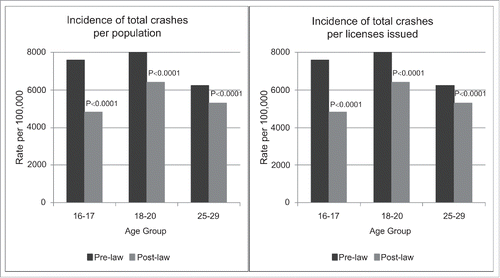
Figure 5. Comparison of Before and After Graduated Driver Licensing Law in Massachusetts on the Rate of Fatal Motor Vehicle Crashes in the State. Source: Kaafarani et al.33
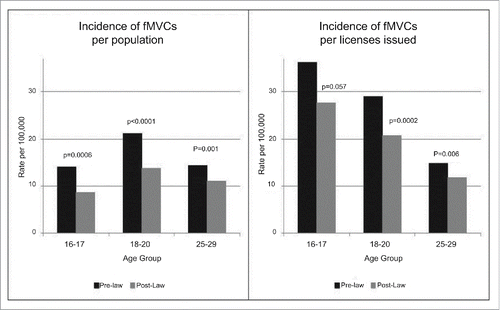
The above discussion strongly reinforces the need for more initiatives aimed at preventing MVCs through well-thought-out policy interventions. As important, it is almost certain that the law simultaneously saved lives and saved money and thus stands as yet another clear example of how implementing injury prevention laws, policies, and interventions is a “low-hanging fruit” in efforts aimed at improving the health of a population. In recent years, all 50 states and the District of Columbia have enacted some form of Graduated Driver Licensing Law provisions. However, in the absence of federal legislation, the strength of the Graduated Driver Licensing Law provisions significantly varies by state, and only a few states satisfy all five of the Insurance Institute for Highway Safety’s recommendations for effective Graduated Driver Licensing Law provisions: (1) minimum permit age of 16, (2) licensing age of 17 years, (3) 70 hours of supervised driving, (4) night driving restriction starting at 8 p.m., and (5) prohibition of teen passengers with the novice driver.
Similar to the above-discussed Graduated Driver Licensing Laws, we believe that health policy interventions that decrease inherently risky driving behaviors can be effective in further decreasing the pandemic of MVCs. In a study by Lee et al.,35 it was reported that states with primary seat belt laws had significantly lower rates of MVC fatalities compared to states with secondary seat belt laws. Such findings indicate that more aggressive health policies may prevent injuries more effectively, such as, for example, replacing secondary seat belt laws in many states by primary seat belt laws that allow fines solely for failure of occupants to wear the seat belt. Though the essence of trauma injury prevention is changing the overall safety culture of a society, there is little doubt that changing a society’s culture requires, at initial stages, sound health policy decisions that gradually shift people’s behaviors toward the intended goal.
CONCLUSION
As policy makers struggle to allocate scarce resources across the five health system reform “control knobs” of financing, organization, payment, behavior change, and regulation to ultimately improve population health,36 injury prevention programs deserve particular attention. The rationale is straightforward: regulatory and behavioral change efforts specifically aimed at injury primary and secondary prevention, if well designed, can be successful, cost-effective, and sustainable in the long term.
DISCLOSURE OF POTENTIAL CONFLICTS OF INTEREST
No potential conflicts of interest were disclosed.
REFERENCES
- Debas H, Gosselin R, McCord C, Thind A. Surgery. In: Disease control priorities in developing countries, 2nd ed., Jamison D, ed. New York: Oxford University Press; 2006.
- National Research Council. Accidental death and disability: the neglected disease of modern society. Washington, DC: The National Academies Press; 1966.
- World Health Organization. The top 10 causes of death. 2014. Available at http://www.who.int/mediacentre/factsheets/fs310/en/index2.html ( accessed 25 May 2015)
- National Center for Injury Prevention and Control. Web-based Injury Statistics Query and Reporting System (WISQARS). 2015. Available at http://www.cdc.gov/injury/wisqars/index.html ( accessed 25 May 2015)
- Finkelstein EA, Corso PS, Miller TR. Incidence and economic burden of injuries in the United States. New York: Oxford University Press; 2006.
- Centers for Disease Control and Prevention. Leading causes of death. 2015. Available at http://www.cdc.gov/injury/overview/leading_cod.html ( accessed 29 May 2015)
- Centers for Disease Control and Prevention, National Center for Injury Prevention and Control. National action plan for child injury prevention. Atlanta, GA: Centers for Disease Control and Prevention, National Center for Injury Prevention and Control; 2012.
- Centers for Disease Control and Prevention. National Vital Statistics System for the National Center for Health Statistics. Available at http://www.cdc.gov/nchs/nvss.htm ( accessed 29 May 2015)
- Children’s Safety Network. Injury prevention: what works? A summary of cost–outcome analysis for injury prevention programs. Available at http://www.childrenssafetynetwork.org/sites/childrenssafetynetwork.org/files/InjuryPreventionWhatWorks.pdf ( accessed 29 May 2015)
- US Department of Health and Human Services. WISQARS (Web-based Injury Statistics Query and Reporting System). Atlanta, GA: Centers for Disease Control and Prevention; 2010. Available at http://www.cdc.gov/injury/wisqars ( accessed 29 May 2015)
- Insurance Institute for Highway Safety. Teenagers: fatality facts. Available at http://www.iihs.org/iihs/topics/t/teenagers/fatalityfacts/teenagers ( accessed 29 May 2015)
- Insurance Institute for Highway Safety, Highway Loss Data Institute. Available at http://www.iihs.org ( accessed 29 May 2015)
- Injury Prevention & Control. Data & statistics (WISQARS). Atlanta, GA: Center for Disease Control and Prevention; 2013.
- Dee TS, Grabowski DC, Morrisey MA. Graduated driver licensing and teen traffic fatalities. J Health Econ 2005; 24(3): 571-589.
- Hedlund J, Shults RA, Compton R. Graduated driver licensing and teenage driver research in 2006. J Safety Res 2006; 37(2): 107-121.
- O’Connor RE, Lin L, Tinkoff GH, Ellis H. Effect of a graduated licensing system on motor vehicle crashes and associated injuries involving drivers less than 18 years-of-age. Prehosp Emerg Care 2007; 11(4): 389-393.
- Shope JT, Molnar LJ. Graduated driver licensing in the United States: evaluation results from the early programs. J Safety Res 2003; 34(1): 63-69.
- Sibbald B. Graduated driver licensing in Canada: slowly but surely. CMAJ 2007; 176(6): 752.
- Williams AF, Tefft BC, Grabowski JG. Graduated driver licensing research, 2010–present. J Safety Res 2012; 43(3): 195-203.
- Beck KH, Hartos J, Simons-Morton B. Teen driving risk: the promise of parental influence and public policy. Health Educ Behav 2002; 29(1): 73-84.
- Begg D, Langley J, Broughton J, Brookland R, Ameratunga S, McDowell A. New Zealand drivers study: a follow-up study of newly licensed drivers. Inj Prev 2009; 15(4): e2.
- Begg D, Stephenson S. Graduated driver licensing: the New Zealand experience. J Safety Res 2003; 34(1): 99-105.
- Gillan JS. Legislative advocacy is key to addressing teen driving deaths. Inj Prev 2006; 12(Suppl 1): i44-i48.
- Garay L, Benavente M. Graduated driver licensing: literature review. (Report No. 04-G022-001). 2004. Available at http://www.ecs.umass.edu/masssafe/PDFS%20for%20Site/Additional%20Projects/GDL%20Lit%20Review.pdf ( accessed 29 May 2015)
- Curry AE, Pfeiffer MR, Localio R, Durbin DR. Graduated driver licensing decal law. Am J Prev Med 2013; 44(1): 1-7.
- Ehsani JP, Bingham CR, Shope JT. The effect of the learner license graduated driver licensing components on teen drivers’ crashes. Accid Anal Prev 2013; 59: 327-336.
- Ehsani JP, Bingham CR, Shope JT. Graduated driver licensing for new drivers: effects of three states’ policies on crash rates among teenagers. Am J Prev Med 2013; 45(1): 9-18.
- Jones SJ, Begg DJ, Palmer SR. Reducing young driver crash casualties in Great Britain—use of routine police crash data to estimate the potential benefits of graduated driver licensing. Int J Inj Contr Saf Promot 2013; 20(4): 321-330.
- Russell KF, Vandermeer B, Hartling L. Graduated driver licensing for reducing motor vehicle crashes among young drivers. Cochrane Database Syst Rev 2011; 10: 1-66.
- Toledo T, Lotan T, Taubman-Ben-Ari O, Grimberg E. Evaluation of a program to enhance young drivers’safety in Israel. Accid Anal Prev 2012; 45: 705-710.
- Ulmer RG, Preusser DF, Williams AF, Ferguson SA, Farmer CM. Effect of Florida’s graduated licensing program on the crash rate of teenage drivers. Accid Anal Prev 2000; 32(4): 527-532.
- Williams AF, Chaudhary NK, Tefft BC, Tison J. Evaluation of New Jersey’s graduated driver licensing program. Traffic Inj Prev 2010; 11(1): 1-7.
- Kaafarani HM, Lee J, Cropano C, Chang Y, Raybould T, Klein E, Gervasini A, Petrovick L, DePesa C, Camargo CA Jr, et al. The impact and sustainability of the graduated driver licensing program in preventing motor vehicle crashes in Massachusetts. J Trauma Acute Care Surg 2015; 78(2): 265-270.
- Sangji NF, Ramly EP, Kaafarani HM, Seethala R, Raybould T, Camargo CA Jr, Velmahos G, Masiakos PT, Lee J. Health care utilization and charges following the enactment of the 2007 Graduated Drivers Licensing Law in Massachusetts. J Pediatr Surg 2015; 50(10): 1791-1796.
- Lee LK, Monuteaux MC, Burghardt LC, Fleegler EW, Nigrovic LE, Meehan WP, Schutzman SA, Mannix R. Motor vehicle crash fatalities in states with primary versus secondary seat belt laws: a time-series analysis. Ann Intern Med 2015; 163(3): 184-190.
- Roberts MJ, Hsiao WC, Berman P, Reich MR. Getting health reform right: a guide to improving performance and equity. New York: Oxford University Press; 2004.
- Centers for Disease Control and Prevention. Injury Prevention & Control: Data & Statistics (WISQARS™). 2015. Available at http://www.cdc.gov/injury/overview/leading_cod.html (accessed 12 October 2015)
- Centers for Disease Control and Prevention. Protect the Ones You Love: Child Injuries are Preventable. 2012. Available at http://www.cdc.gov/safechild/NAP/background.html (accessed 18 May 2015)
